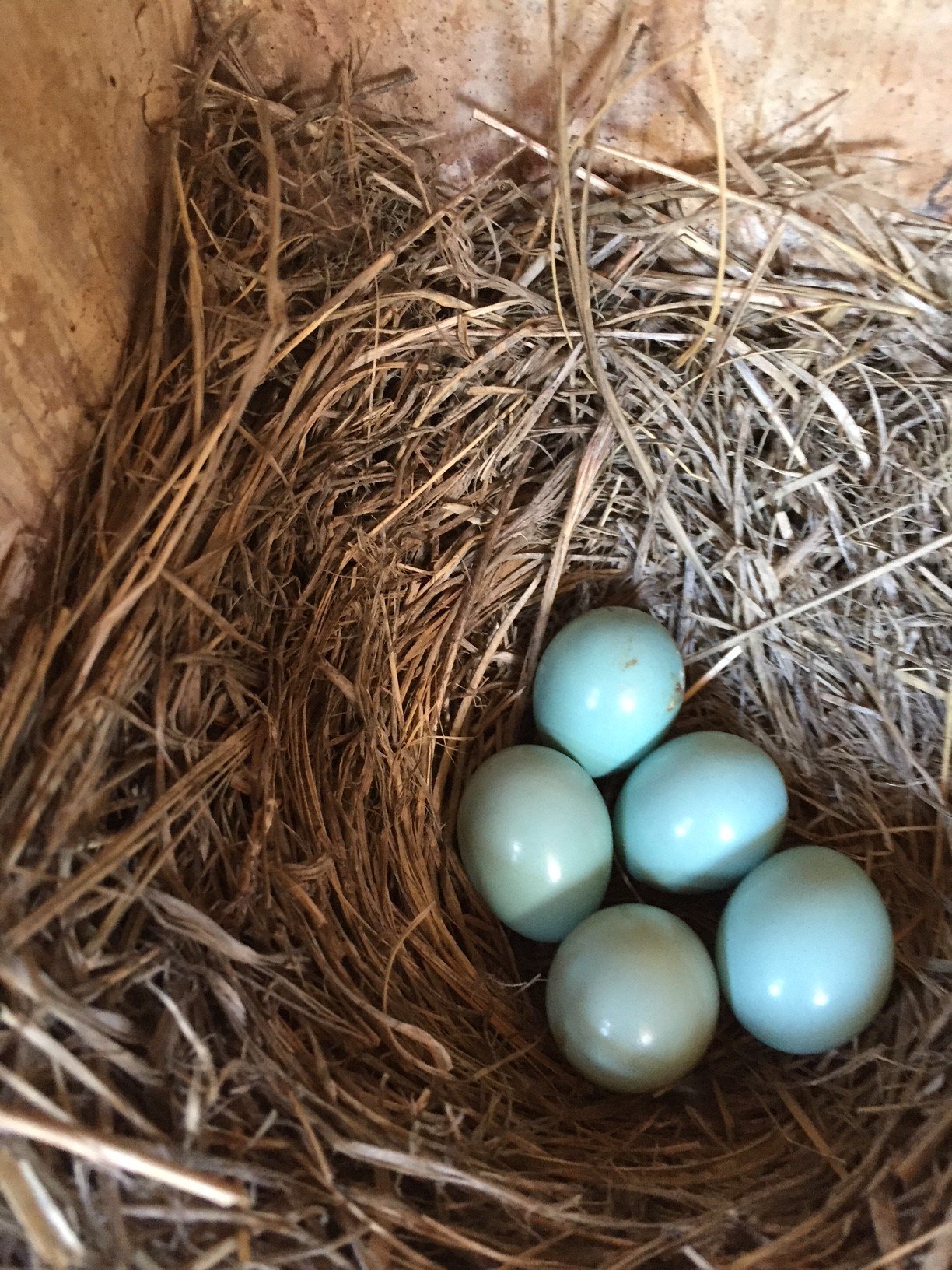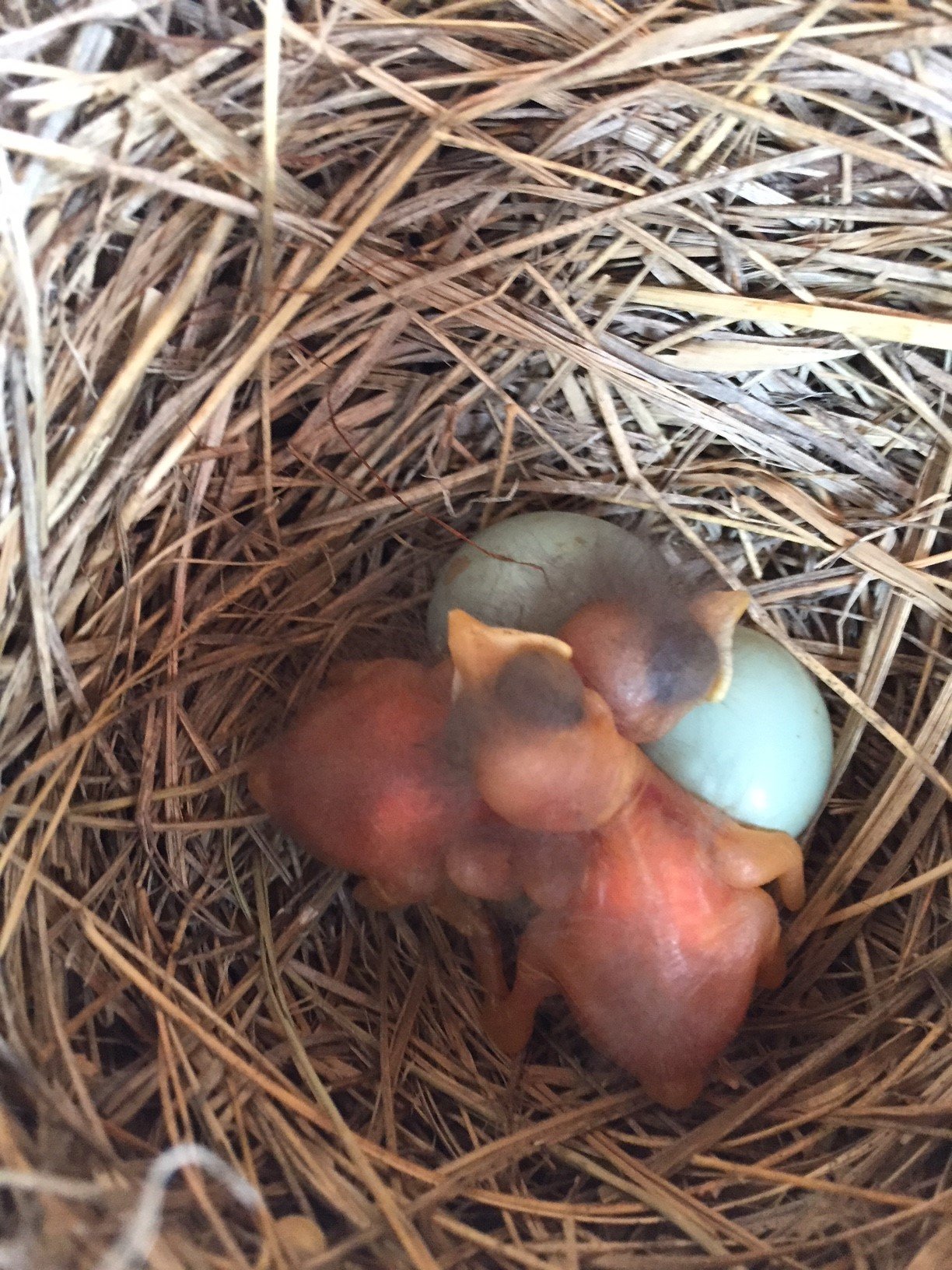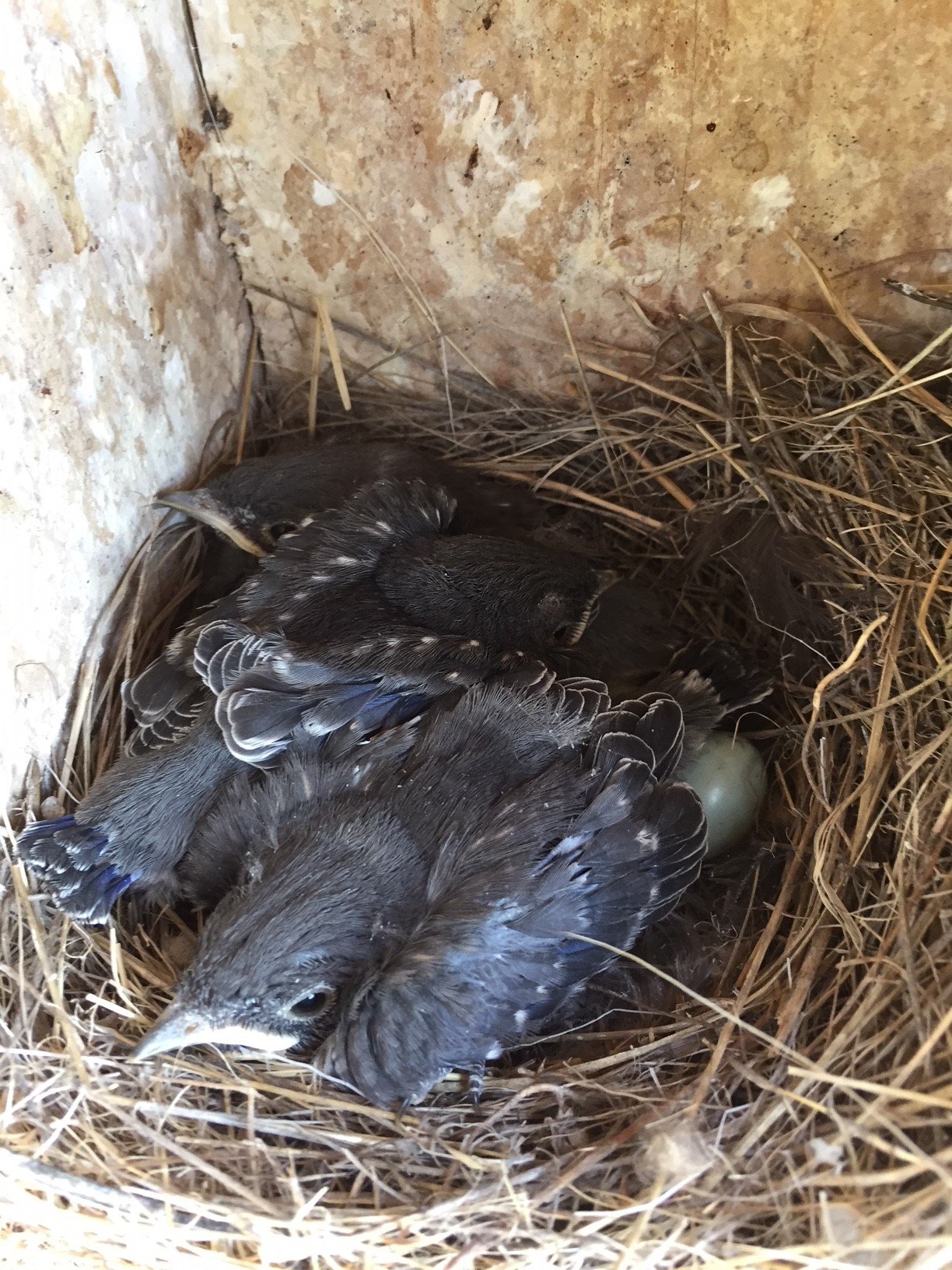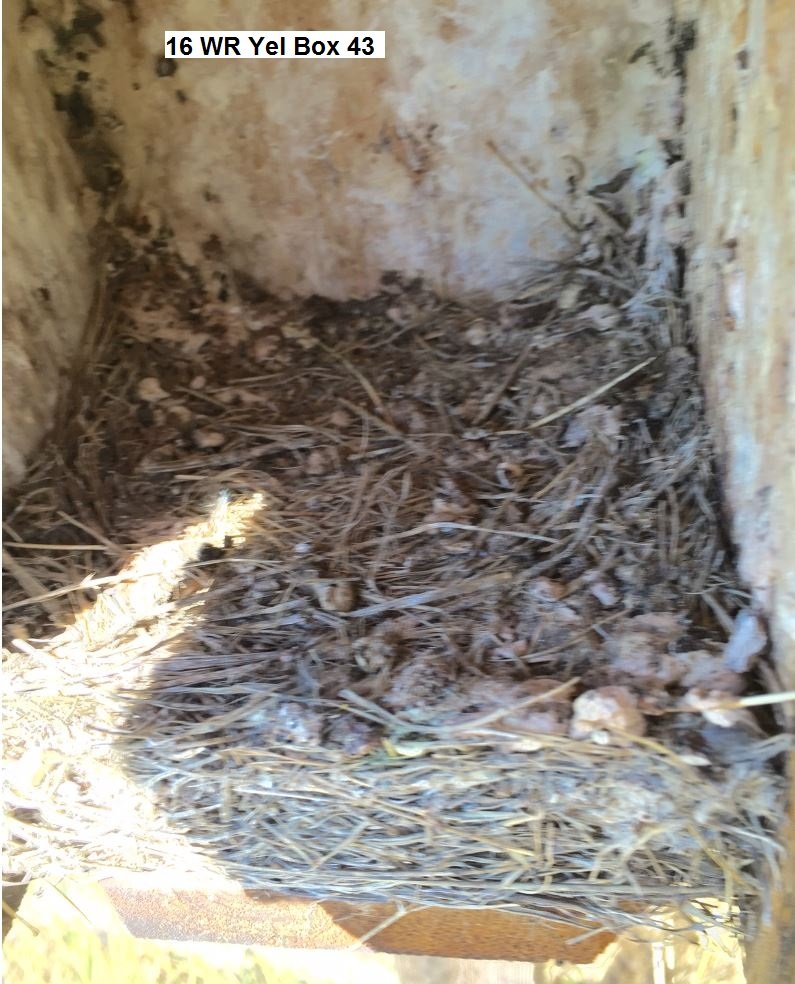2021 Was Not a Good Year for Bluebirds
By Bob Parker, Boulder County Audubon Bluebird Coordinator
2021 was a disappointing year for Mountain and Western Bluebirds in Colorado. The data from our Boulder County Open Space and Boulder County Audubon bluebird monitoring combined with the data from the entire state of Colorado bluebird box surveys shows fewer bluebirds fledged in 2021 than in 2020. The decline wasn’t due to the number of birds fledged per nest but instead the total number of nests. There were significantly fewer overall nesting attempts in 2021 than in 2020. Something happened to reduce the number of birds returning to nest in 2021 and a likely culprit is the 2020 drought which was quite severe over a significant portion of their migration route.
Bluebird Nesting Cycle Photo Gallery
These five photos show typical progression through a Mountain Bluebird nesting cycle. Mountain Bluebirds have an incubation period of 18-21 days and then remain in the nest for 18-25 days before fledging.





Boulder County Bluebird Box Route Summary
Boulder County Audubon has operated ten bluebird nest box routes on Boulder County Open Space properties for over 15 years. There are four routes on Walker Ranch, two routes on Betasso Preserve, two routes on Heil Ranch, one on Bald Mountain, and one on Minnick (along the Peak to Peak Highway north of Nederland). Both routes on Heil Ranch were destroyed by the Cal Wood fire in October 2020 and have not yet been replaced. Hopefully, the county open space will give us permission to replace the boxes for the 2022 season, as bluebirds are one of the first species to reenter burned forests. To learn more about bluebirds and other early species in burned areas, All About Birds has a great article.
Most of the boxes on one of the routes at Betasso and at Minnick were moved in 2021 to better locations. As the trees grow, the habitat changes and some of the boxes cease being attractive to the bluebirds. Boxes occasionally need to be moved on all of the routes to ensure we continue to monitor in habitat appropriate for bluebirds. Additionally, every year a few boxes are destroyed by bears, chewed by squirrels or raccoons, and just wear out. These boxes may be replaced or moved.
2021 had the lowest nest box occupancy at Walker Ranch in the last six years (Table 1). The Walker Ranch Yellow route circles the open field around the main ranch house east of the Walker Ranch Loop Trailhead and consists of 11-12 boxes in ideal bluebird habitat. From 2016 through 2020, we had only one unoccupied box across all five years. In 2021, four of the boxes were empty. Tree and Violet-green Swallows and House Wrens also nest in these boxes. The number of swallows and House Wrens occupying the boxes in 2021 was consistent with past years. So empty boxes seem to be entirely due to fewer bluebirds nesting in 2021. Hopefully we will see more bluebirds in 2022, as we did in 2019 after a down year in 2018!
Table 1. Walker Ranch yellow route nest box occupancy in 2021. If a box had more than one species occupy it per season only the first nest is counted.
| Total Boxes | Mountain Bluebirds | Western Bluebirds | % with Bluebirds | Tree & VG Swallows | House Wren | Empty | % Empty | |
| 2016 | 12 | 10 | 0 | 83.3% | 2 | 0 | 0 | 0.0% |
| 2017 | 11 | 9 | 0 | 81.8% | 3 | 0 | 0 | 0.0% |
| 2018 | 11 | 5 | 1 | 54.5% | 3 | 1 | 1 | 9.1% |
| 2019 | 12 | 8 | 1 | 75.0% | 2 | 1 | 0 | 0.0% |
| 2020 | 12 | 7 | 1 | 66.7% | 3 | 1 | 0 | 0.0% |
| 2021 | 12 | 4 | 0 | 33.3% | 2 | 2 | 4 | 33.3% |
Colorado Bluebird Box Monitoring Summary
Using data provided by Colorado state bluebird coordinator Kevin E. Corwin for 2020 and 2021 from the state’s 1500 or so bluebird boxes (Tables 3 and 4 at the end of the article), I find that the patterns seen in Boulder county hold true across the state (Table 2).
Table 2. Percent increase in nesting-related metrics between 2020 and 2021 for all species recorded by the Colorado Bluebird Project (negative numbers represent a decrease in 2021). Data for Juniper Titmouse, Barn Swallow, and bluebird sp. are excluded from this table as they had zero nesting attempts in either 2020 or 2021.
|
Species |
Nest Attempts |
Total Eggs |
Unhatched Eggs |
Nestlings |
Fledglings |
|
Mountain Bluebird |
-35.8% |
-35.3% |
-20.7% |
-38.6% |
-39.1% |
|
Tree Swallow |
-14.9% |
-13.2% |
-24.4% |
-8.4% |
-18.2% |
|
Western Bluebird |
-47.4% |
-47.5% |
-38.6% |
-52.2% |
-50.4% |
|
Violet-green Swallow |
6.5% |
3.6% |
5.7% |
-0.5% |
4.0% |
|
House Wren |
-9.6% |
-7.2% |
260.0% |
3.9% |
0.0% |
|
Mountain Chickadee |
35.0% |
55.1% |
66.7% |
53.0% |
64.6% |
|
White-breasted Nuthatch |
45.5% |
45.5% |
100.0% |
32.7% |
41.9% |
|
Pygmy Nuthatch |
16.7% |
42.0% |
-63.2% |
78.0% |
104.7% |
|
Tree/Violet-green Swallow |
300.0% |
278.6% |
NA |
225.0% |
141.7% |
|
Ash-throated Flycatcher |
133.3% |
163.6% |
500.0% |
110.0% |
112.5% |
|
swallow sp. |
-57.1% |
-30.0% |
-33.3% |
-36.4% |
-45.5% |
|
Black-capped Chickadee |
133.3% |
125.0% |
200.0% |
52.9% |
76.9% |
|
Total Across All Species |
-25.2% |
-23.9% |
-21.9% |
-24.6% |
-27.2% |
Swallows and bluebirds, the most common residents in our Boulder County Audubon boxes, are also the most common across the state. Mountain Bluebirds had 36% fewer nesting attempts and 39% fewer fledglings in 2021 relative to 2020. Western Bluebirds suffered a 47% decline in nesting attempts and 50% fewer fledglings in 2021 relative to 2020. Tree Swallows fared a little better with only a 15% decline in nesting attempts and an 18% decline in total fledglings. Chickadees and nuthatches showed an opposite pattern with both increasing their nesting attempts and fledging numbers, however, these species have quite low occupancy of nest boxes and so a small change in the number of nests means a dramatic percentage increase. House Wren nesting attempts and total fledglings were similar in the two years.
You will also notice a total of 25% fewer nesting attempts overall in 2021 relative to 2020. This was due mostly to empty boxes, and not to a reduction in the number of boxes available. We hope that more boxes will be used in 2022 and that the drought conditions will be vastly improved compared with past years.
Conclusions
Western and Mountain Bluebird nesting attempts suffered declines of 47% and 36%, respectively, in Colorado in 2021 compared to 2020. Average eggs per attempt and nestlings per attempt were very similar in 2021 and 2020, so the reduction in birds was due to fewer nests attempted in 2021. I believe that drought conditions along the migration route and/or in their wintering grounds were responsible for the reduction in nesting attempts in 2021. It is hoped that more birds will return to nest in 2022 and numbers will begin to recover.
Table 3. Summary of all activity in Colorado Bluebird Project nest boxes for 2020. Data compiled by Kevin E. Corwin.
| Species | Nesting attempts | Eggs | Unhatched eggs | Nestlings | Fledglings |
| Mountain Bluebird | 531 | 2583 | 382 | 2101 | 1921 |
| Tree Swallow | 483 | 2401 | 349 | 1862 | 1564 |
| Western Bluebird | 302 | 1499 | 228 | 1227 | 1080 |
| Violet-green Swallow | 62 | 251 | 35 | 195 | 174 |
| House Wren | 52 | 291 | 5 | 229 | 211 |
| Mountain Chickadee | 20 | 98 | 6 | 83 | 82 |
| White-breasted Nuthatch | 11 | 55 | 2 | 49 | 43 |
| Pygmy Nuthatch | 12 | 69 | 19 | 50 | 43 |
| Tree/Violet-green Swallow | 3 | 14 | 0 | 12 | 12 |
| Ash-throated Flycatcher | 3 | 11 | 1 | 10 | 8 |
| swallow sp. | 7 | 20 | 6 | 11 | 11 |
| Black-capped Chickadee | 3 | 20 | 3 | 17 | 13 |
| Juniper Titmouse | 0 | 0 | 0 | 0 | 0 |
| bluebird sp. | 0 | 0 | 0 | 0 | 0 |
| Barn Swallow | 1 | 4 | 1 | 3 | 3 |
| Total Observed | 1490 | 7316 | 1037 | 5849 | 5165 |
Table 4. Summary of all activity in Colorado Bluebird Project nest boxes for 2021. Data compiled by Kevin E. Corwin.
| Species | Nesting attempts | Eggs | Unhatched eggs | Nestlings | Fledglings |
| Mountain Bluebird | 341 | 1671 | 303 | 1289 | 1169 |
| Tree Swallow | 411 | 2084 | 264 | 1705 | 1280 |
| Western Bluebird | 159 | 787 | 140 | 586 | 536 |
| Violet-green Swallow | 66 | 260 | 37 | 194 | 181 |
| House Wren | 47 | 270 | 18 | 238 | 211 |
| Mountain Chickadee | 27 | 152 | 10 | 127 | 135 |
| White-breasted Nuthatch | 16 | 80 | 4 | 65 | 61 |
| Pygmy Nuthatch | 14 | 98 | 7 | 89 | 88 |
| Tree/Violet-green Swallow | 12 | 53 | 8 | 39 | 29 |
| Ash-throated Flycatcher | 7 | 29 | 6 | 21 | 17 |
| swallow sp. | 3 | 14 | 4 | 7 | 6 |
| Black-capped Chickadee | 7 | 45 | 9 | 26 | 23 |
| Juniper Titmouse | 1 | 5 | 0 | 5 | 5 |
| bluebird sp. | 1 | 8 | 0 | 8 | 8 |
| Barn Swallow | 0 | 0 | 0 | 0 | 0 |
| Total Observed | 1114 | 5564 | 810 | 4412 | 3762 |
